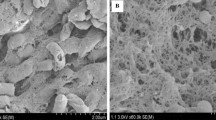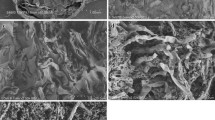Abstract
The mycelia of Aspergillus niger, cultivated in a medium containing 45 g l−1 maltose, 66 g l−1 yeast extract, and 5 g l−1 K2HPO4 at 30°C and 200 rpm, were used as a biocatalyst in the glucosylation of ascorbic acid. Free mycelia from 3-day-old culture, when used in a 6-h reaction with maltose as the acyl donor, gave 16.07 g l−1 ascorbic acid glucoside corresponding to a volumetric productivity of 2.68 g l−1 h−1 and a conversion of 67%. Mycelia from 3-day-old cultures were entrapped in calcium alginate beads and used as a catalyst in the glucosylation of ascorbic acid. An ascorbic acid-to-maltose molar ratio of 1:9 was found to be optimum, and the conversion reached 75% after 12 h. The concentration of ascorbic acid glucoside produced at this molar ratio was 17.95 g l−1, and the productivity was 1.5 g l−1 h−1. The biocatalyst was repeatedly used in a fixed bed bioreactor for the synthesis of ascorbic acid glucoside and approximately 17 g l−1 of ascorbic acid glucoside corresponding to a volumetric productivity of 1.42 g l−1 h−1 was produced in each use. The conversion was retained at 70% in each use. The entrapped mycelia also exhibited exceptionally high reusability and storage stability. The product was purified to 85% by anion exchange and gel permeation chromatography with a final yield of 75%.






Similar content being viewed by others
References
Bae HK, Lee SB, Park CS, Shim JH, Lee HY, Kim MJ, Baek JS, Roh HJ, Choi JH, Choe EO, Ahn DU, Park KH (2002) Modification of ascorbic acid using transglucosylation activity of Bacillus stearothermophilus amylase to enhance its oxidative stability. J Agric Food Chem 50:3309–3316
Benson CP, Kelly CT, Fogarty WM (1982) Production and quantification of transglucosidase from Aspergillus niger. J Chem Technol Biotechnol 32:790–798
Bradford MM (1976) A rapid and sensitive method for the quantitation of microgram quantities of protein utilizing the principle of protein–dye binding. Anal Biochem 72:248–254
Campbell JA, Davies GJ, Bulone V, Henrissat B (1997) A classification of nucleotide-diphospho-sugar glycosyltransferases based on amino acid sequence similarities. Biochem J 326:929–939
Chen WC, Hung TF, Lee SF (1997) Production of glucosyl-transferring enzyme by Aspergillus niger in batch cultures. Biotechnol Lett 19:949–951
Coutinho PM, Deleury E, Davies GJ, Henrissat B (2003) An evolving hierarchical family classification for glycosyltransferases. J Mol Biol 328:307–317
Gainer JL, Kirwan DJ (1984) Immobilization of microorganisms. Ann NY Acad Sci 434:465–467
Gregory JF (1998) Nutritional properties and significance of vitamin glycosides. Ann Rev Nutr 18:227–296
Hsieh HJ, Giridhar R, Wu WT (2006) Production of ascorbyl palmitate by surfactant-coated lipase in organic media. J Agric Food Chem 54:5777–5781
Jun HK, Bae KM, Kim SK (2001) Production of 2-O-α-D-glucopyranosyl L-ascorbic acid using cyclodextrin glucanotransferase from Paenibacillus sp. Biotechnol Lett 23:1793–1797
Humeau C, Girardin M, Rovel B, Miclo A (1998) Enzymatic synthesis of fatty acid vitamin-C esters. J Mol Catal B Enzym 5:19–23
Kang HH, Oh SG (2003) Synthesis of L-ascorbic acid derivative including 3-aminopropane phosphoric acid as a novel whitening agent. Bull Korean Chem Soc 24:1169–1171
Karel SF, Libicki SB, Robertson CR (1985) The immobilization of whole cells: engineering principles. Chem Eng Sci 40:1321–1354
Kennedy JF, Melo EHM, Jumel K (1990) Immobilized enzymes and cells. Chem Eng Prog 86:81–89
Klinkeberg G, Lystad KQ, Levine DW, Dyrset N (2001) Cell release from alginate immobilized Lactococcus lactis ssp. lactis in chitosan and alginate coated beads. J Dairy Sci 84:118–127
Lee CH, Seib PA, Liang YT, Liang YT, Hoseney RC, Deyoe CW (1978) Chemical synthesis of several phosphoric esters of L-ascorbic acid. Carbohydr Res 67:127–138
Lee SB, Nam KC, Lee SJ, Lee JH, Inouye K, Park KH (2004) Antioxidative effects of glycosyl-ascorbic acids synthesized by maltogenic amylase to reduce lipid oxidation and volatiles production in cooked chicken meat. Biosci Biotechnol Biochem 68:36–43
Lee SL, Chen WC (1997) Optimization of medium composition for the production of glucosyltransferase by Aspergillus niger with response surface methodology. Enzym Microb Technol 21:436–440
Long JC, Lee WC, Guo SH (2000) Immobilization of cell-associated enzyme by entrapping in gluten matrix. Biocatal Biotransform 17:431–443
Mandai T, Yoneyama M, Sakai S, Muto N, Yamamoto I (1992) The crystal structure and physicochemical properties of L-ascorbic acid 2-glucoside. Carbohydr Res 232:197–205
McCleary BV, Gibson TS (1989) Purification, properties and industrial significance of transglucosidase from Aspergillus niger. Carbohydr Res 185:147–162
Murad S, Grove D, Lindberg KA, Reynolds G, Sivarajah A, Pinnell SR (1981) Regulation of collagen synthesis by ascorbic acid. Proc Natl Acad Sci USA 78:2879–2882
Muto N, Terasawa K, Yamamoto I (1992) Evaluation of ascorbic acid 2-O-. a. -glucoside as vitamin C source: mode of intestinal hydrolysis and absorption following oral administration. Int J Vit Nutr Res 62:318–323
Nomura H, Ishiguro T, Morimoto S (1989) Studies on L-ascorbic acid derivatives. II. L-ascorbic acid 3-phosphate and 3-pyrophosphate. Chem Pharm Bull (Tokyo) 17:38l–386
Olav S, Gudmund SB (1990) Alginate as immobilization matrix for cells. Trends Biotechnol 8:71–78
Park S, Viklund F, Hult K, Kazlauskas RJ (2003) Vacuum-driven lipase-catalysed direct condensation of L-ascorbic acid and fatty acids in ionic liquids: synthesis of a natural surface active antioxidant. Green Chem 5:715–719
Pazur JH, Ando T (1959) The action of an amyloglucosidase of . Aspergillus niger. on starch and malto-oligosaccharides. J Biol Chem 234:1966–1970
Sakai S, Yoneyama M, Miyake T (1995) Crystalline 2-O-α-D glucopyranosyl-L-ascorbic acid and its preparation and uses. US Patent 5407812
Scott CD (1987) Immobilized cells: a review of recent literature. Enzym Microb Technol 9:66–73
Shintaro F (1988) Engineering aspects of immobilized biocatalysts. J Chem Eng Jpn 21:219–230
Sierks MR, Svensson B (1994) Protein engineering of the relative specificity of glucoamylase from Aspergillus awamori based on sequence similarities between starch degrading enzymes. Protein Eng 7:1479–1484
Tai A, Goto S, Ishiguro Y, Suzuki K, Nitoda T, Yamamoto I (2004) Permeation and metabolism of a series of novel lipophilic ascorbic acid derivatives, 6-O-acyl-2-O-α-D-glucopyranosyl-l-ascorbic acids with a branched-acyl chain, in a human living skin equivalent model. Bioorg Med Chem Lett 14:623–627
Tai A, Fujinami Y, Matsumoto K, Kawasaki D, Yamamoto I (2002) Bioavailability of a series of novel acylated ascorbic acid derivatives, 6-O-Acyl-2-O-α-D-glucopyranosyl-L-ascorbic acids, as an ascorbic acid supplement in rats and guinea pigs. Biosci Biotechnol Biochem 66:1628–1634
Viklund F, Alander J, Hult K (2003) Antioxidant properties and enzymatic synthesis of ascorbyl fatty acid esters. J Am Oil Chem Soc 80:795–799
Watanabe T, Sato T, Yoshioka S, Koshijima T, Kuwahara M (1992) Purification and properties of Aspergillus niger beta-glucosidase. Eur J Biochem 209:651–659
Wenrong S, Griffiths MW (2000) Survival of bifidobacteria in yogurt and simulated gastric juice following immobilization in gellan–xanthan beads. Int J Food Microbiol 61:17–25
Woodward J (1988) Methods of immobilization of microbial cells. J Microbiol Methods 8:91–102
Yamamoto I, Muto N, Murakami K, Suga S, Yamaguchi H (1990) L-Ascorbic acid α-glucoside formed by regioselective transglucosylation with rat intestinal and rice seed α-glucosidase: its improved stability and structure determination. Chem Pharm Bull 38:3020–3023
Yamamoto I, Muto N, Miyake T (1992) a-Glucosyl-L-ascorbic acid, and its preparation and uses. US patent 5137723
Yoshiko TO, Maedia M, Nakao M, Yoshimura M, Tomimori NS, Fukami H (2004) 2-O-(β-D-glucopyranosyl) ascorbic acid, a novel ascorbic acid analogue isolated from Lycuim fruit. J Agric Food Chem 52:2092–2096
Acknowledgment
This research was supported by grants (NSC 94-2214-E-006-016) from the National Science Council of Taiwan.
Author information
Authors and Affiliations
Corresponding author
Rights and permissions
About this article
Cite this article
Hsieh, HJ., Tung, KY., Nair, G.R. et al. Production of ascorbic acid glucoside by alginate-entrapped mycelia of Aspergillus niger . Appl Microbiol Biotechnol 77, 53–60 (2007). https://doi.org/10.1007/s00253-007-1148-9
Received:
Revised:
Accepted:
Published:
Issue Date:
DOI: https://doi.org/10.1007/s00253-007-1148-9




